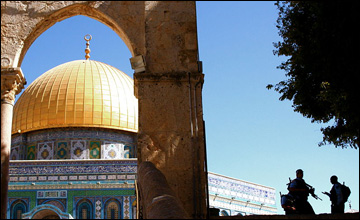Meeting Ground
Meeting Ground
Michael Walzer on Where Heaven and Earth Meet
 THERE ARE many ways of making peace—even in the Middle East where one might think there wasn’t any way at all. Where Heaven and Earth Meet: Jerusalem’s Sacred Esplanade is an example of academic and intellectual peacemaking. It deals with what might be the most fiercely disputed piece of territory in the world—a few thousand acres at the very center of the Israeli-Palestinian conflict and in the very center of Jerusalem. The book is edited by an Israeli and an American; it is sponsored by the Hebrew University, Al-Quds University, and the Catholic Ecole biblique de Jerusalem. Its writers include Israelis, Palestinians, and Europeans; Jews, Muslims, and Christians. It isn’t hard to imagine the months and years of diplomacy that were required to make this project possible.
THERE ARE many ways of making peace—even in the Middle East where one might think there wasn’t any way at all. Where Heaven and Earth Meet: Jerusalem’s Sacred Esplanade is an example of academic and intellectual peacemaking. It deals with what might be the most fiercely disputed piece of territory in the world—a few thousand acres at the very center of the Israeli-Palestinian conflict and in the very center of Jerusalem. The book is edited by an Israeli and an American; it is sponsored by the Hebrew University, Al-Quds University, and the Catholic Ecole biblique de Jerusalem. Its writers include Israelis, Palestinians, and Europeans; Jews, Muslims, and Christians. It isn’t hard to imagine the months and years of diplomacy that were required to make this project possible.
The diplomacy began–or perhaps this came at the end—with the subtitle of the book. The bit of land in question is called Har ha-Bayit (literally Mountain of [the Lord’s] House or Temple Mount) by Jews and al-Haram al-Sharif (The Noble Sanctuary) by Muslims. “Sacred Esplanade” is a nice compromise; in the book itself, each author chooses the name he or she prefers. “Where Heaven and Earth Meet,” the book’s first title will bother only secularists, who have little stake in this conflict.
The essays collected by Oleg Grabar and Benjamin Kedar (a couple are also written by them) deal with the history and architecture of the esplanade from the tenth century BCE until the day before yesterday. There isn’t much disagreement about the history. Yasir Arafat famously denied that an Israelite temple ever stood on the site (it was actually in Yemen, he said). But the earliest Muslim sources insist that the Dome of the Rock was built precisely where the Temple stood. There are periods about which little is known, like the first two or three centuries of the Second Temple (from 538 to 300 or so BCE), but where there is knowledge it is common knowledge.
Only for the most recent period, “1917 to the Present,” did the editors find it necessary to present two accounts, one written by two Israelis from Hebrew University and the Israel Antiquities Authority and the other by a Palestinian from the Rawaq Center for Architectural Conservation in Ramallah. Still, the two pieces differ in tone and judgment but not much in their accounts of what actually happened. The book as a whole is a tribute to the idea of actuality, which postmodernists have described as an impossible goal. It turns out that even extreme political disagreements can yield, at least for a few moments, to the demands of historical scholarship.
Where Heaven and Earth Meet is a beautiful book, lavishly illustrated, with detailed discussions of temple and mosque architecture, and with an additional “photographic dossier” by the Syrian-Jordanian-American photographer Said Nuseibeh. Beauty isn’t a political subject; it is rarely at issue in Dissent magazine; but here a shared recognition of beauty may have made the diplomacy easier.
The editors and writers don’t try to resolve the question, “Whose place is this?” Historically, it has been the place of all the players—a Jewish site for about 1000 years until seventy CE; a Roman site (but the Romans are not contenders today) for a few centuries; a Christian site for a few more centuries until 635; a Muslim site until 1099; a Christian site again for the ninety years of Crusader rule; and a Muslim site ever since–subject for a time to British and, since 1967, to Israeli control, but administered by the Islamic Waqf (Religious Endowments) Ministry. What is needed today is a political arrangement for the esplanade that reflects this history while also respecting the status quo of the moment. The politics that might bring this about is not yet visible, but it probably won’t be entirely unlike the politics necessary to produce this book.
Michael Walzer is Dissent‘s co-editor. He and Nicolaus Mills edited the Dissent-Penn Press book, Getting Out: Historical Perspectives on Leaving Iraq.
Photo: Dome of the Rock (John Barnett / Wikimedia Commons / Creative Commons 2.5)






